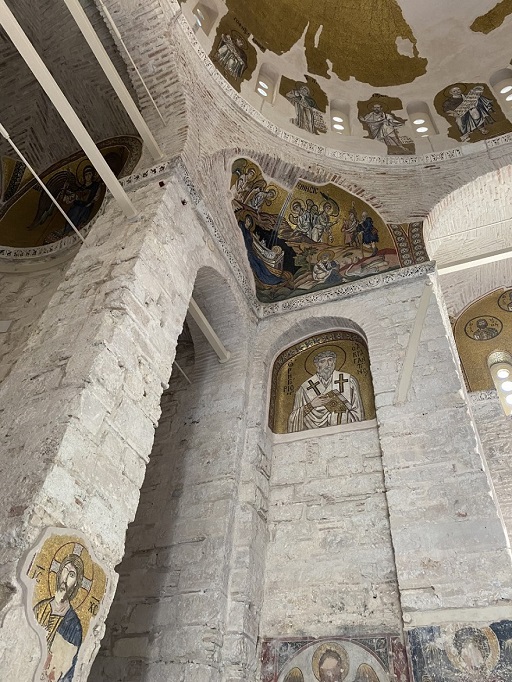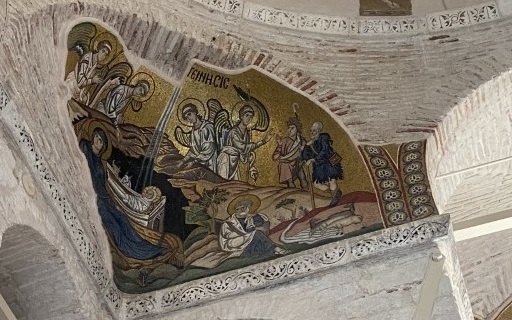3 The Nativity of Christ
A mosaic depicting the Nativity of Christ is situated in the church of monastery at Daphni, outside Athens. Looking back to Week 1, Section 3.2, this is a pendentive. The scene is identified by an inscription in Greek capital letters in black, seen at the top middle part.
Activity 1 The Nativity of Christ
Look closely at Figure 11, and provide a short description in the text box underneath.
Discussion
The Virgin and baby Jesus in the manger dominate the centre foreground of the scene. The Virgin is lying with her head placed to the left, while the swathed baby Jesus is in the manger with His head to the right. Two animals are by the side of the manger. The manger is situated before the dark opening of a large cave. Joseph can be seen to the bottom right of the scene, sitting on rocks and looking to the left where the Virgin and baby Jesus are. Four angels flank the scene at the back, two on either side. Three white lines are beaming down from Heaven to baby Jesus.
In Appendix 2 [Tip: hold Ctrl and click a link to open it in a new tab. (Hide tip)] , try to locate the Gospel passages that narrate this event. You can easily access the King James Bible online at: kingjamesbibleonline.org. Alternatively you can use a search engine, by typing ‘King James Bible’ followed by the Evangelist and the chapter and verse you are looking for (e.g., ‘King James Bible Luke 1:26’). Identify and read the Gospel narratives that are depicted in the scene. How comparable are the words and the visual representation?
Comment
The Nativity of Christ is narrated by two of the four Evangelists: Matthew 1:18-25 and 2:1-23; and Luke 2:1-20.
Studying the image in close relation to the text, it is clear that it is closer to Luke 2:1-20. Luke describes how Jesus was born in a manger (as there was no other place in Nazareth due the overpopulation of the city at the time, due to the taxation ordered by Augustus). Jesus is depicted lying in swaddling clothes. Angels are depicted in the background of the scene; the two to the right announce the birth of Jesus to the shepherds.
Matthew’s passage on the Nativity is much longer, and also describes the Adoration of the Magi, the Massacre of the Innocents and the angel coming to Joseph in a dream to warn him about Herod’s intentions. The Massacre of the Innocents is depicted as a separate scene in Byzantine art, but the Magi’s Journey is often included in the background of the Nativity in Byzantine art (but evidently not in the Monastery of Daphni, most likely due to lack of space). Nevertheless, there are two details here that could point to Matthew’s narrative: the star that guided the Magi (Matthew 2:2 and 2:9-10), in the shape of the three rays shining down from Heaven onto baby Jesus; and the ‘grumpy’ figure of Joseph, a ‘standard’ way of presenting Jesus’ adopted father in Byzantine art, probably suggesting Joseph’s ‘disappointment’ that his young wife, Mary, was pregnant not by him (Matthew 1:19-20; the narrative goes on to describe how an angel informed Joseph of the situation – it is very interesting that Byzantine art opted to visualise Joseph’s original and very ‘human’ reaction).


